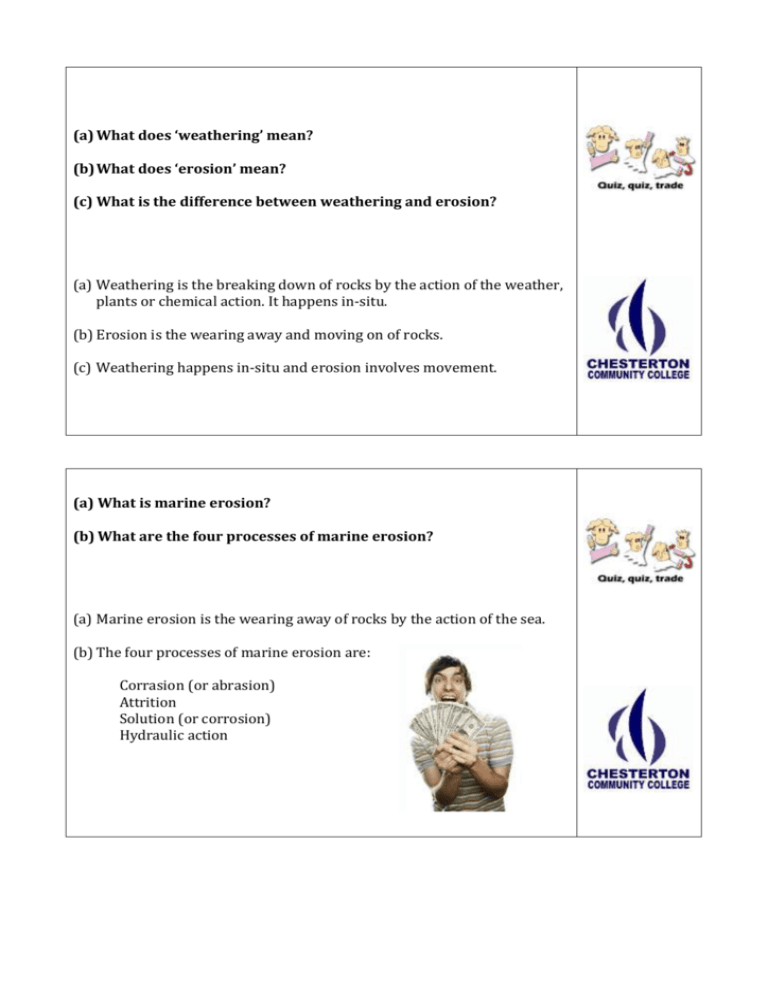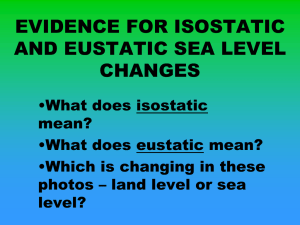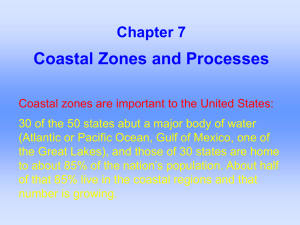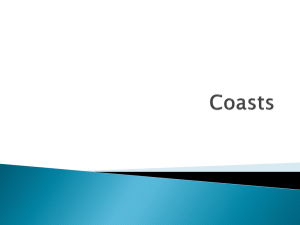Quiz Quiz Trade coasts revision
advertisement

(a) What does ‘weathering’ mean? (b) What does ‘erosion’ mean? (c) What is the difference between weathering and erosion? (a) Weathering is the breaking down of rocks by the action of the weather, plants or chemical action. It happens in-situ. (b) Erosion is the wearing away and moving on of rocks. (c) Weathering happens in-situ and erosion involves movement. (a) What is marine erosion? (b) What are the four processes of marine erosion? (a) Marine erosion is the wearing away of rocks by the action of the sea. (b) The four processes of marine erosion are: Corrasion (or abrasion) Attrition Solution (or corrosion) Hydraulic action (a) What is corrasion (abrasion)? (b) What is attrition? (c) What is solution (corrosion)? (d) What is hydraulic action? (a) Rocks are flung at the cliff face. This damages the rocks and the cliff face. It is also called sandblasting. (b) Pebbles carried in the waves knock into each other, gradually making them rounder and smoother. (c) The dissolving of certain types of rock such as chalk and limestone by the sea. (d) As waves hit a cliff face, air is compressed into cracks, blasting away fragments of rock. (a) What does the term ‘multi-use area’ mean? (b) Give examples of the land uses in Southampton. (a) An area that is used for lots of different things eg. recreation, industry, shopping. (b) Here are some examples: ExxonMobil oil refinery Fawley chemical plant Lymington sailing resort Cowes sailing resort Keyhaven Nature Reserve West Quay regional shopping centre Southampton University Calshot Activity Centre Port of Southampton Lepe Country Park Housing (a) What characteristics does a constructive wave have? (b) What characteristics does a destructive wave have? (a) Constructive waves are long, low waves that spill onto the beach. They have a strong swash and a weak backwash so they build up the beach. (b) Destructive waves are short, steep waves that plunge onto the beach with force. They have a strong wash and a weak backwash so they destroy the beach. (a) What are sub-aerial processes? (b) Give examples of sub-aerial processes. (a) Processes that attack the face and top of a cliff. (b) Animal burrowing; rainwater; wind. Draw a diagram to show how LSD works. Draw a diagram to show why bays and headlands form. (a) What is a rockfall? (b) What happens in a landslide? (c) What is a mudslide or mudflow? (d) What is a cliff slump? (a) Rapid free-fall of rock from a steep cliff face due to gravity. (b) After being soaked by water, cliffs made from soft rock will begin to slip due to the rock being lubricated. The movement takes place along a flat plane (known as a slip plane). (c) A rapid, sudden movement that occurs after periods of heavy rain. When there is not enough vegetation to bind it together and hold it in place, saturated clay flows out of the cliff face, like a river of mud. (d) It is very much like a landslide. Heavy rainfall makes the rock heavier due to it absorbing the water and the water also acts as a lubricant. The difference with slumping is that it happens on a concave surface. What is a spit and how does it form? A spit is an extended stretch of beach that points out to sea and is joined to the mainland at one end. Spits are created by deposition. Spits are formed where the prevailing wind blows at an angle to the coastline, resulting in longshore drift. Where there is a break in the coastline and a slight drop in energy, longshore drift will deposit material at a faster rate than it can be removed and gradually a ridge is built up. This continues to grow by the process of longshore drift and the deposition of material. A change in prevailing wind direction often causes the end of spits to become hooked (also known as a recurved end). (a) How does a groyne work? (b) How does a sea-wall work? (c) How does rock armour work? (a) A groyne works by sticking out into the sea and preventing material being moved along by LSD so that material is kept on the beach. (b) A sea-wall is a barrier between the sea and the land. The waves crash onto the sea wall, protecting the land behind. The power of the waves is deflected back to sea. (c) Rock armour works by absorbing the power of the waves. (a) What are the four DEFRA coastal management criteria? (b) Do a line dance to show that you understand the four criteria! (a) The four criteria are: Advance the line Hold the line Retreat the line No active intervention (a) What is beach recycling? (b) What is beach reprofling? (a) Beach recycling is taking material that has been moved by LSD from one end of the beach to the other so that LSD can move it again. (b) Beach reprofiling is where the shape of the beach is changed. Bulldozers are used to push material back up the beach to create a gently sloping beach profile. Why are some coastal areas protected and others not? Some areas are protected because the costs of doing so are less than the benefits. This tends to be the case when there is lots of expensive infrastructure in place eg. a town, a gas terminal, a holiday resort, a main road. Other areas are not protected because the costs of protection are higher than the benefits. This tends to be the case when there is a rural area, particularly if the farmland is poor quality. (a) What kind of coastal management is being used at Minehead and Porlock Bay? (b) Why is there a difference in approach between these two places? (a) Minehead has a seawall, rock amour (rip-rap) and groynes. Porlock Bay has managed retreat. (b) Minehead is a big town with lots of infrastructure, including a Butlins’ holiday camp that brings lots of money into the region. Porlock Bay is a nature reserve. Flooding the area provides a habitat for wetland species. Why are coral reefs important? They contain rare species of plants and animals. They form a barrier that protects coasts from storm waves. They provide nutrients for fish stocks, which helps local fishing industries. They are a major tourist attraction, with over 250 million visitors a year. What is managed realignment (managed retreat)? Managed realignment (managed retreat) usually involves breaching an existing coastal defence, such as a sea wall or an embankment and allowing the land behind to be flooded by the incoming tide, thus setting back the line of actively maintained coastline. This land is then left to be colonised by saltmarsh vegetation. When established, the vegetation disperses wave energy during storm events, reduces erosion rates and provides an important habitat for coastal flora and fauna. If the newly breached area is backed by low-lying land, a new embankment (earth bund) is usually constructed beforehand on the landward side of the site to reduce the risk of flooding. What pressures does the Mediterranean coastal area face? Increasing levels of sea pollution as industrial waste and untreated sewage are pumped into the sea. Increased urbanisation of the coastal areas as the population increases. Damage to environments by the development of hotels and resorts. Growing threat of desertification as increasing amounts of underground water are used. Growing levels of air pollution from industry and transport. Increased risk of accidents as the number of ships in the Mediterranean Sea increases. Water shortages because of increases in demand and climate change. (a) What is the swash? (b) What is the backwash? (c) What is the fetch? (d) What does prevailing wind mean? (e) Why does the south west coast of the Isle of Wight have much bigger waves than the north west coast? (a) Swash is the movement of a wave up the beach. (b) Backwash is the movement of a wave down the beach. (c) Fetch is the distance of open water over which the wind can blow. (d) Prevailing winds is the most common wind direction. (e) The fetch is longer, allowing the wind to blow over the surface for a long time and make big waves. Draw a diagram to show the erosion of a headland. (a) What is a wave cut platform? (b) How do wave cut platforms form? (a) A wide, gently sloping rocky surface at the foot of a cliff. (b) When waves break against a cliff, erosion close to the high-tide line takes a ‘bite’ out of the cliff to form a feature called a wave-cut notch. Over a long period of time, the notch gets deeper until the overlying cliff can no longer support its own weight and collapse. This keeps happening,. Over time, the cliff line retreats and in its place will be a gently sloping rocky platform called a wave cut platform. What is the difference between hard engineering and soft engineering? Hard engineering is building artificial structures such as sea walls aimed at controlling natural processes. It works against these processes. Soft engineering is a more sustainable approach to managing the coast as it does not use artificial structures. Instead, it tries to work with the natural processes. An example is managed retreat. How is the beach at Pevensey Bay being managed? There are lots of groynes to reduce longshore drift. Beach replenishment – from the seabed and from beaches to the west. The sand is sprayed onto the beach from a ship. Beach recycling – moving sand by lorry from the east end of the beach to the west end (to counteract LSD). Beach reprofiling – using bulldozers to push material up the beach Tyre bales – over 40,000 compressed car tyres were buried to provide a stable base for the replenishment of the beach. How is the Great Barrier Reef Marine Park being managed? Any organisation or project wanting to use the reef has to prepare a full report on how the environment will be affected. Tourists and tourism companies must obtain permits before diving, camping or fishing in the area. Staff at the visitor education centres make sure people know how their trips will affect the reef. Ten patrol boats check for illegal activity in the park and there are very heavy fines for criminal activity such as polluting the reef. The reef is zoned –activities can only be carried out in designated zones and there are different zones for different activities. (a) What is ICZM? (b) How is the Mediterranean coastal area being managed in an integrated way? (a) ICZM is integrated coastal zone management. It is about managing the whole of the coastal area, not just the narrow strip where the land meets the sea. (b) The Mediterranean Plan Bleu was introduced in 2006. It aims to: Make 10% of all coastal areas into nature reserves Reduce building development along the coast Develop inland tourism to relieve the pressure on the coast Issue guidelines to ensure that tourist developments fit with the environment Treat all waste water before it is pumped into the sea and have stricter pollution rules Encourage the use of water conservation methods (a) What is sustainable management? (b) Give some examples of sustainable management of the coastline. (a) Sustainable management is management that meets the needs of the present while preserving an area for future generations. It can continue into the future. (b) Some examples: Managed retreat at Porlock or at Medmerry. ICZM in the Mediterranean How does a bar form? Bars are created where a spit grows across a bay, joining two headlands. Draw a diagram to show the process of managed retreat. Why does the coast attract increasing numbers of people? Coastal areas provide economic, environmental and recreational opportunities so lots of people wish to live on or near the coast. Business development in coastal areas creates job opportunities and the physical environment provides an attractive place to live. The growing interest in outdoor recreational activities makes coastal areas increasingly appealing. Deep-water ports allow large container ships and ferries to unload. This creates lots of jobs in the area. Oil refineries are often located at the coast so that the tankers can dock. What is the difference between a swash-aligned beach and a driftaligned beach? A swash-aligned beach is formed when the waves approach parallel to the coastline and the swash and backwash move the sediment up and down the beach. This creates a wide beach with an even profile. During storms, ridges of sediment (berms) can form. A drift-aligned beach is formed when the waves approach at an angle to the coastline. The swash moves sediment up the beach at the same angle as the waves, while the backwash moves the material straight back down the beach under the force of gravity.

![PERSONAL COMPUTERS CMPE 3 [Class # 20524]](http://s2.studylib.net/store/data/005319327_1-bc28b45eaf5c481cf19c91f412881c12-300x300.png)






